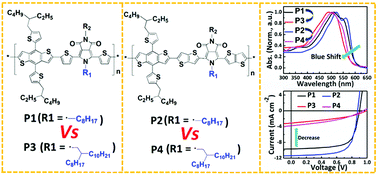当前位置:
X-MOL 学术
›
New J. Chem.
›
论文详情
Our official English website, www.x-mol.net, welcomes your
feedback! (Note: you will need to create a separate account there.)
Pyrrole N-alkyl side chain effects on the properties of pyrrolo[3,4-c]pyrrole-1,3-dione-based polymers for polymer solar cells
New Journal of Chemistry ( IF 2.7 ) Pub Date : 2018-06-08 00:00:00 , DOI: 10.1039/c8nj01715h Vellaiappillai Tamilavan 1, 2, 3, 4 , Jihoon Lee 1, 2, 3, 4 , Dal Yong Lee 1, 2, 3, 4 , Rajalingam Agneeswari 2, 4, 5, 6 , Yun Kyung Jung 4, 7, 8, 9 , Youngeup Jin 2, 4, 5, 6 , Jung Hyun Jeong 1, 2, 3, 4 , Myung Ho Hyun 4, 10, 11, 12 , Sung Heum Park 1, 2, 3, 4
New Journal of Chemistry ( IF 2.7 ) Pub Date : 2018-06-08 00:00:00 , DOI: 10.1039/c8nj01715h Vellaiappillai Tamilavan 1, 2, 3, 4 , Jihoon Lee 1, 2, 3, 4 , Dal Yong Lee 1, 2, 3, 4 , Rajalingam Agneeswari 2, 4, 5, 6 , Yun Kyung Jung 4, 7, 8, 9 , Youngeup Jin 2, 4, 5, 6 , Jung Hyun Jeong 1, 2, 3, 4 , Myung Ho Hyun 4, 10, 11, 12 , Sung Heum Park 1, 2, 3, 4
Affiliation

|
In this study, two new pyrrolo[3,4-c]pyrrole-1,3-dione (PPD)-based polymers (P3 and P4) incorporating a 2-octyldodecyl (branched alkyl) group on the pyrrole nitrogen of the PPD unit were prepared. Their properties were briefly compared to those of the structurally quite similar PPD-based polymers (P1 and P2) with an n-octyl (linear alkyl) group on the PPD unit, in order to understand the importance of the pyrrole N-alkyl group. The calculated optical band gaps (Eg) and highest occupied molecular orbital energy levels of P3 and P4 were found to be around ∼0.1 eV higher and deeper, respectively, compared to those of the respective linear alkylated polymers P1 and P2. The maximum power conversion efficiency (PCE) obtained for the polymer solar cells made by using P3 or P4:PC70BM blends without any additive was around ∼2%, which was quite similar to that of the PSCs made using P1 or P2:PC70BM blends. However, P3 and P4 exhibited a notably lower PCE than that of P1 and P2, respectively, when the polymer solar cells were created with an additive. This study confirmed that the alkyl substituent on the pyrrole nitrogen of the PPD unit significantly affects the properties of the resulting polymer.
中文翻译:

吡咯N-烷基侧链对吡咯并[3,4- c ]吡咯-1,3-二酮类聚合物用于聚合物太阳能电池性能的影响
在这项研究中,两种新的吡咯并[3,4- c ]吡咯-1,3-二酮(PPD)基聚合物(P3和P4)在PPD单元的吡咯氮上结合了2-辛基十二烷基(支链烷基)基团准备好了。将它们的性质与结构上非常相似的PPD单元上具有正辛基(直链烷基)的基于PPD的聚合物(P1和P2)的性质进行了简要比较,以了解吡咯N-烷基的重要性。计算的P3和P4的带隙(E g)和最高占据分子轨道能级。与相应的直链烷基化聚合物P1和P2相比,发现分别约高约0.1eV和更深。使用不含任何添加剂的P3或P4:PC 70 BM混合物制得的聚合物太阳能电池的最大功率转换效率(PCE)约为2%,这与使用P1或P2:PC制成的PSC的功率转换效率非常相似。70 BM混合物。但是,P3和P4的PCE明显低于P1和P2分别是在使用添加剂制成聚合物太阳能电池时。这项研究证实,PPD单元的吡咯氮上的烷基取代基会显着影响所得聚合物的性能。
更新日期:2018-06-08
中文翻译:

吡咯N-烷基侧链对吡咯并[3,4- c ]吡咯-1,3-二酮类聚合物用于聚合物太阳能电池性能的影响
在这项研究中,两种新的吡咯并[3,4- c ]吡咯-1,3-二酮(PPD)基聚合物(P3和P4)在PPD单元的吡咯氮上结合了2-辛基十二烷基(支链烷基)基团准备好了。将它们的性质与结构上非常相似的PPD单元上具有正辛基(直链烷基)的基于PPD的聚合物(P1和P2)的性质进行了简要比较,以了解吡咯N-烷基的重要性。计算的P3和P4的带隙(E g)和最高占据分子轨道能级。与相应的直链烷基化聚合物P1和P2相比,发现分别约高约0.1eV和更深。使用不含任何添加剂的P3或P4:PC 70 BM混合物制得的聚合物太阳能电池的最大功率转换效率(PCE)约为2%,这与使用P1或P2:PC制成的PSC的功率转换效率非常相似。70 BM混合物。但是,P3和P4的PCE明显低于P1和P2分别是在使用添加剂制成聚合物太阳能电池时。这项研究证实,PPD单元的吡咯氮上的烷基取代基会显着影响所得聚合物的性能。











































 京公网安备 11010802027423号
京公网安备 11010802027423号